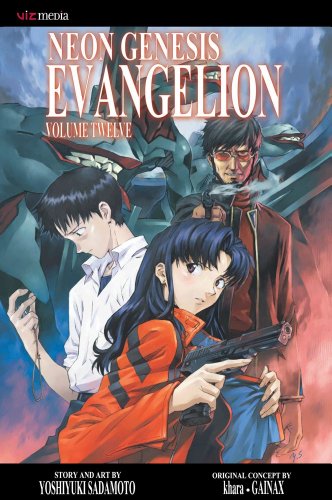
Question Tuesday: Manga matters
The Good Comics for Kids Question Tuesday column is here to do one thing: answer your questions! Borrowing the idea from novelist John Green (you can check out his famously entertaining video blog with his brother Hank, vlogbrothers, including his Question Tuesday videos, here), we aim to answer all your burning questions about comics, graphic novels, and manga every Tuesday.
To send in your questions for the next Question Tuesday, please go to our form here. We will endeavor to answer as many questions as possible in our weekly column. This week we only got one but it’s a great one to tackle! We may have weeks where questions follow a particular theme or point of origin, so if your question does not appear in the next column, it will be featured in a future column. All questions are due in by Friday at midnight so we’ll have a chance to write up the answers for the next week.
ADVERTISEMENT
ADVERTISEMENT
On to the question of the week!
Would Neon Genesis Evangelion by Yoshiyuki Sadamoto belong in the teen or adult collection? It does have some nudity in it. – Vanessa, San Diego, CA
 I get questions like this one about all sorts of series, but Japanese manga most often. Partly this is a question of cultural differences — in Japanese manga, there is more likely to be incidental nudity, for example, as Japanese audiences are not as, well, prudish about nudity as US audiences are. If you take a bath or change clothes, you’re going to be naked for a bit, and the Japanese see no need to cover that up while a US creator would most like include a convenient screen or palm frond. In a series like Neon Genesis Evangelion, which is aimed at older teen guys up through to college, there will be more nudity with intent, shall we say, but there is unlikely to be anything truly explicit.
I get questions like this one about all sorts of series, but Japanese manga most often. Partly this is a question of cultural differences — in Japanese manga, there is more likely to be incidental nudity, for example, as Japanese audiences are not as, well, prudish about nudity as US audiences are. If you take a bath or change clothes, you’re going to be naked for a bit, and the Japanese see no need to cover that up while a US creator would most like include a convenient screen or palm frond. In a series like Neon Genesis Evangelion, which is aimed at older teen guys up through to college, there will be more nudity with intent, shall we say, but there is unlikely to be anything truly explicit.
How do I know who Neon Genesis Evangelion is for?
Here’s a window into how I check this:
There are five major audiences the Japanese manga market targets:
- kodomo (kids of both genders and published very rarely in the US)
- shonen (boys up to teen guys)
- shojo (girls up to teen girls)
- seinen (college age guys and up)
- josei (college age girls and up)
The links included above lead you to the excellent introductions to each type from About.com’s manga expert Deb Aoki. There is also ero manga, or erotic manga, which is aimed at adults and very few libraries collect.
As manga titles are usually serialized in anthology magazines before they are collected into books, a good way to tell the audience is to check what the original publishing magazine was and what other kinds of titles they included. To find this out, there are two easy places to check: Wikipedia and the Anime News Network’s Encyclopedia. Wikipedia has a solid list of all the manga anthology magazines here, but it’s best to search by series title if you want to locate a specific series.
Both sites will let you know what marketing category a title belongs to and, in the case of ANN’s encyclopedia, will link to a list of other titles published in that same magazine. This gives you a solid idea of what kind of audience the manga was originally created for and thus will help you decide where it best belongs in your collection.
For this example, if you look up Neon Genesis Evangelion, you see this on Wikipedia, on the right-hand information bar:
 Wikipedia lists the series as both shonen and seinen, reflecting that it was originally published in a boys magazine (Shonen Ace) and then continued in a young man’s magazine (Young Ace.)
Wikipedia lists the series as both shonen and seinen, reflecting that it was originally published in a boys magazine (Shonen Ace) and then continued in a young man’s magazine (Young Ace.)
Anime News Network further link to lists of the other titles published if you follow each magazine’s title link.
Those who know manga magazines recognize that anything with shonen in the title means that it’s marketed to guys up to teenagers (hence Shonen Jump and Shonen Sunday, two magazines we have here in the US.) Anything with young in the title is for college age guys and up. In the case of Neon Genesis Evangelion, you can see that it shared chapters with titles like Code Geass, Eureka Seven, and The Melancholy of Haruhi-Suzumiya in Shonen Ace while it rubbed shoulders with Kurosagi Corpse Delivery Service and MPD-Psycho (two decidedly adult series) in Young Ace. The company a series keeps helps you guess what kind of content it may have (and will have in the future.)
ADVERTISEMENT
ADVERTISEMENT
Now, knowing the original Japanese audience doesn’t always follow through to who the series is read by here in the US. The most puzzling examples for US readers include Kaoru Mori’s charming Victorian romance Emma and Kiyohiko Azuma’s adorable Yotsuba&!, both of which were originally published in seinen magazines but are mainly read by female and younger readers here. However, knowing the original market for a manga title helps explain the content.
Neon Genesis Evangelion is a classic series for guys, and most libraries I know of have it in their teen sections. Of all the libraries that own it in my system, 13 have it in YA, one has it in Children’s, and two have it in adult.
There is some nudity, but it’s not too explicit or for a long sequence of panels. Given the Japanese don’t react as strongly to nudity in their comics and media, it’s unsurprising that there is some present, especially considering the series shifted from a shonen magazine up to a seinen magazine.
It is, of course, up to the librarian. Selectors know their own community’s best. I suggest thinking about how a manga compares to other visual media the library owns like movies or videogames. Is it PG-13 imagery or R-rated? Also, does the library have an adult collection that you’d be able to move it to? Do you think teen or adult patrons are the ones who are going to seek out the series? Armed with the information on how the original audience and your own community mesh, you should be well on your way to placing it wisely for your library.
Filed under: Question Tuesday
About Robin Brenner
Robin Brenner is Teen Librarian at the Brookline Public Library in Massachusetts. When not tackling programs and reading advice at work, she writes features and reviews for publications including VOYA, Early Word, Library Journal, and Knowledge Quest. She has served on various awards committees, from the Will Eisner Comic Industry Awards to the Boston Globe Horn Book Awards. She is the editor-in-chief of the graphic novel review website No Flying No Tights.
ADVERTISEMENT
ADVERTISEMENT
SLJ Blog Network
Happy Poem in Your Pocket Day!
This Q&A is Going Exactly As Planned: A Talk with Tao Nyeu About Her Latest Book
Parsing Religion in Public Schools
Environmental Mystery for Middle Grade Readers, a guest post by Rae Chalmers
ADVERTISEMENT








